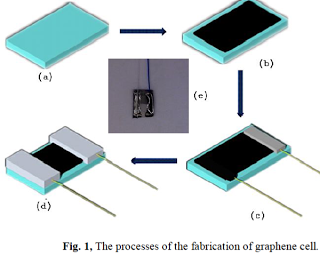Arxiv – Graphene can collect energy from the ambient heat and convert it to electricity, which makes it an ideal candidate for the fabrication of self-powered devices. However, this technology is suffering the high cost, which limits the practical use of it. In this work, we demonstrated that the cost can be reduced by using low cost reduced graphene oxide (RGO), graphite electrodes and low cost glass substrates. The results showed that this technology can be of practical value for the “battery” industry.
Graphene batteries haver been suffering several disadvantages, such as high cost for the fabrication of high quality graphene. The cost of gold electrod was also very high when considering making it a large scale one. Besides, the substrate of the graphene device, means SiO2/ Silicon wafer, also limits the application of the device. Here, we demonstrated that graphene “battery” can be made of low cost Reduced Graphene Oxides (RGO). We also replaced the gold electrode with graphite, which cuts the cost a lot. Besides, glass, instead of silicon dioxide/ silicon substrate was used in this work, showing the potential of making this product much cheaper and makes the processes much simpler.
The fabrication of the graphene electricity generator is shown
(a), Glass substrates were cleaned by ultrasonic cleaner in acetone for 10 minutes then in isopropanol for another 10 minutes. Then the substrates were exposed to oxygen plasma cleaner to make the surface hydrophilic;
(b), Then the 3% GO solution was spun onto the surface of glass by a spin coater with a speed of 800rpm/min for 40 seconds. Then, the glass was annealed at 250oC for 20 mins to reduce the GO film. After the annealing process, the color of the surface of glass changed to gray from light yellow;
(c), Silver coated copper wire were adhered to each side of the RGO film by silver paste and graphite paste, respectively;
(d), The electrodes were sealed by transparent glue to prevent them from exposing to the solution. One
The output power was tested by loading different resistors to one sample. The results showed that the output power reached a peak when a 3.2 K Ohm resistor was loaded to the circuit. The peak power density was about 0.17uW, lower than the value that in the previous work.
In conclusion, this work demonstrated the possibility of producing low cost graphene ‘battery’ by using low cost reduced graphene oxide, low cost electrodes and substrates. Although the performance of this device was not as good as the device made of CVD graphene used in the previous work, the low cost will make it possible for practical use.And the output power density will be further increased by improving the quality of RGO.
If you liked this article, please give it a quick review on ycombinator or StumbleUpon. Thanks

Brian Wang is a Futurist Thought Leader and a popular Science blogger with 1 million readers per month. His blog Nextbigfuture.com is ranked #1 Science News Blog. It covers many disruptive technology and trends including Space, Robotics, Artificial Intelligence, Medicine, Anti-aging Biotechnology, and Nanotechnology.
Known for identifying cutting edge technologies, he is currently a Co-Founder of a startup and fundraiser for high potential early-stage companies. He is the Head of Research for Allocations for deep technology investments and an Angel Investor at Space Angels.
A frequent speaker at corporations, he has been a TEDx speaker, a Singularity University speaker and guest at numerous interviews for radio and podcasts. He is open to public speaking and advising engagements.


